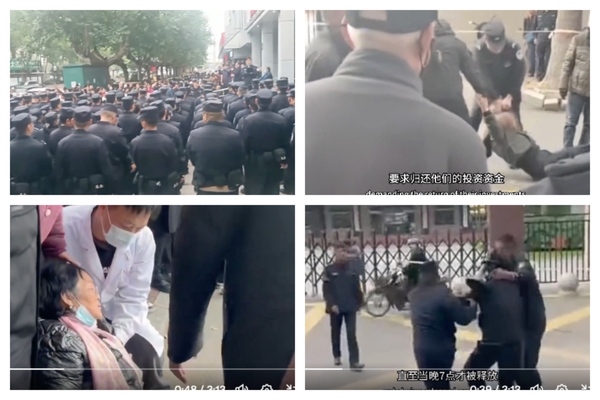In August of this year, the “Civil Lending Center” led by the government of Hancheng City, Shaanxi Province, exploded with losses amounting to as much as 1.1 billion yuan (RMB). On November 10, hundreds of investors gathered in front of the Hancheng City government demanding the return of their investment funds. Ten people were arrested on the spot by the police, only to be released by 7 p.m. that evening.
On November 11, a blogger known as “Yesterday” (@YesterdayBigcat) who has been tracking Chinese livelihood and social media platforms, detailed the above situation and uploaded related videos.
The video showed a large number of police on the scene, with people shouting in unison, “Give back the money, give back the money!” “They are hitting people, they are hitting people!” Some were dragged away by the police, and an elderly person fainted on the ground.
On November 12, an investor and victim, Mr. Wang (alias), informed a reporter from Dajiyuan that the Civil Lending Center in Hancheng City was set up by the government and collapsed in August.
“On August 20, 2025, it collapsed; the people did not receive the interest, and the principal was not returned upon maturity. Because one of my (financial) products matured on August 21, and another on August 28, the staff said they would pay me back by September 15, but they also failed to do so.”
He revealed that the investors were mostly from Shaanxi, involving over 2,000 people, mostly aged 50 and above. The invested funds included money saved through years of entrepreneurship, elderly pensions, and dowries prepared for their sons’ weddings. There were investments ranging from a few hundred thousand to several million yuan, totaling approximately 1.1 billion yuan. The official audit lasted for more than a month without any explanation given to the people.
“The government and local police stations frequently call us, telling us to wait patiently, not to gather, and that the government will give us a resolution. However, from the collapse until now, we have not seen any hope,” Mr. Wang said. “These past two days, we have been taking turns speaking with the police station and the local government; our movements and WeChat are under surveillance.”
According to Mr. Wang, from September 15 until two weeks ago, a task force was set up in Hancheng City to provide progress reports every Thursday afternoon and promised to partially refund the investors by October 1, with “one billion yuan expected to be returned by the end of October.” “But so far, no refunds have been made, and on Friday of last week (November 7), nobody met us, leaving us waiting until 6 p.m. with no results.”
“Yesterday” mentioned in a post that in late September 2025, news broke that the financial chain of the Civil Lending Registration Center in Hancheng City had broken, leading to its collapse. According to statistics, as many as 2,200 people were affected, involving around 1.1 billion yuan. The Hancheng City government had announced the “takeover” of the center, promising to introduce a “solution,” but as of yet, no concrete actions have been taken.
As “Yesterday” described, in June 2014, under the leadership of the Hancheng City government, the Civil Lending Registration Service Center in Hancheng City was established, with the then Mayor Zhang Jian Zhong leading the working group. Two deputy mayors, as well as heads of public security, finance, the court, and the financial office, among over ten other department heads, served as deputy group leaders or members. The lending company was positioned as a financial innovation platform guiding the “solarization” and standardization of private capital by the government.
The “Hancheng Daily” once stated that it provided the public with a “risk-free, high-yield financial channel” and reported stories of villagers investing their children’s tuition fees and retirement funds. The government also claimed that there were “no bad loans.”
“Yesterday” stated that with high-profile endorsements and publicity, the lending center introduced financing plans with a monthly return of 8%, attracting a large number of investors. Many of the investors were retirees, small vendors, or farmers who firmly believed in “government regulation, controllable risks,” and some even sold houses and used retirement funds to invest.

